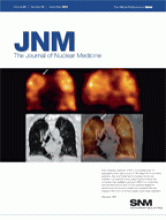Abstract
Methyl-l-11C-methionine (11C-MET) PET has been shown to detect brain tumors with a high sensitivity and specificity. In this study, we investigated the potential of 11C-MET PET to noninvasively detect tumor progression in patients with gliomas. Moreover, we analyzed the relationship between changes in 11C-MET uptake on PET and changes in various molecular immunohistochemical markers during progression of gliomas. Methods: Twenty-four patients with histologically proven glioma were investigated repeatedly with 11C-MET PET. 11C-MET uptake was determined for a circular region of interest. Histologic and molecular analyses for tumor progression were performed after open surgery and stereotactic biopsy, respectively. Results: In patients with malignant progression, the mean increase in 11C-MET uptake was 54.4% (SD, 45.5%; range, 3.1%−162.2%), whereas in patients without a change in tumor grade, mean 11C-MET uptake did not significantly change (3.9%; SD, 13.7%; range, −24.4% to 26.3%). The difference in the change in 11C-MET uptake between the group with malignant progression and the group without malignant progression was highly significant (P < 0.001). Receiver-operating-curve analysis revealed a sensitivity of 90% and a specificity of 92.3% for the detection of malignant transformation by an increase in 11C-MET uptake of more than 14.6%. Increased 11C-MET uptake of more than 14.6% was indicative of malignant progression in all but 3 leave-one-out iterations. A detailed immunohistochemical analysis demonstrated a significant correlation between changes in 11C-MET uptake and the expression of vascular endothelial growth factor. Conclusion: These data suggest that 11C-MET-PET represents a noninvasive method to detect malignant progression in patients with gliomas. Moreover, the increase in 11C-MET uptake during malignant progression is reflected by an increase in angiogenesis-promoting markers as vascular endothelial growth factor.
Footnotes
-
↵* Contributed equally to this work.
-
COPYRIGHT © 2009 by the Society of Nuclear Medicine, Inc.







